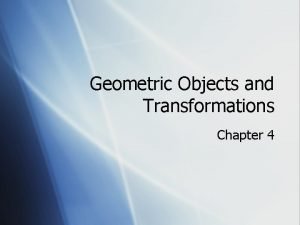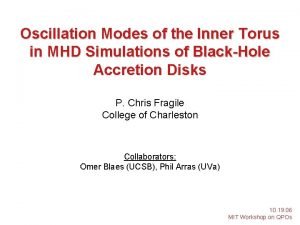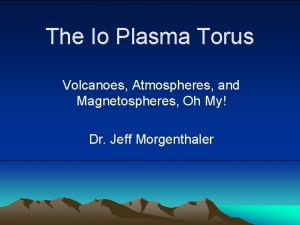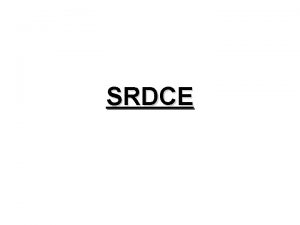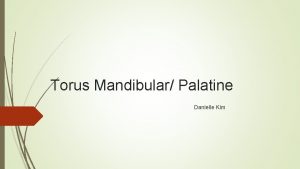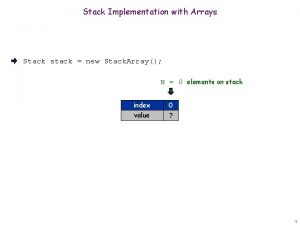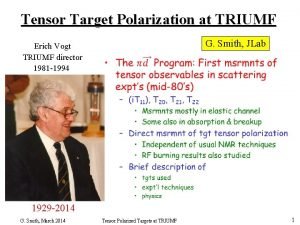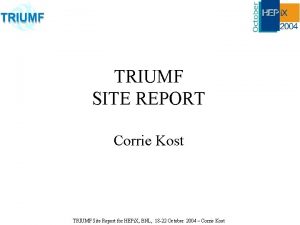G 4 Torus Stack Peter Gumplinger TRIUMF G








- Slides: 8

G 4 Torus. Stack Peter Gumplinger, TRIUMF G 4 Collaboration Meeting ESTEC, October 2010 Slides adopted from information available at: http: //neutrino. phys. ksu. edu/~GLG 4 sim/docs/ html_latest/FAQ. html 1

q. Original work GLG 4 sim for Kam. LAND q. Author: Glenn Horton-Smith G 4 Torus. Stack - to realistically describe the surface of a typical photo-tube (PMT). In a nutshell it allows the definition of a dome surface with varying curvature. q. Used by DEAP/CLEAN, SNO+, Kam. LAND, Micro. Boo. NE (to name a few). • Employ GLG 4 Torus. Stack as their PMT model by ‘word-of-mouth’ distribution. G 4 Torus. Stack: is quite useful volume definition and cannot necessarily be replaced by something existing in the G 4 toolkit. • Adopt it, bring it up to current G 4 geometry standards and maintain it for our users in the 2 future.

What is the “Torus. Stack” solid? A Torus. Stack is a stack of toroidal segments, sliced parallel to their planes of symmetry and stuck together. It is similar to a Poly. Cone, but with toroidal surfaces instead of conical. (Note that the parameters “a” and “b” shown in the following graph are calculated internally, but are not used in defining the Torus. Stack in the code. ) 3

4

What are the parameters z_edge, rho_edge and z_o used to define a Torus. Stack solid? The Torus. Stack class constructor must be passed some arrays that define the shape of the Torus. Stack, as well as the number n of segments in the stack. The array parameters are named z_edge, rho_edge and z_o. The first two arrays are n+1 long, and define the points at which the segments join. The z_o array is n elements, and defines the Z-position of the center of curvature of each segment. The following diagram (taken from the Hamamatsu PMT manual, with annotations added by hand in green), should help make this more clear: 5

6

The PMT manufacturer tells us that the top segment of the Torus. Stack has a radius of curvature of 136. 7 mm. The center of curvature is about 40 mm below the “equator” of the PMT, and the very top of the PMT is about 95 mm above the equator. Taking the equator to be z=0, the value of z_o for the first segment z_o[0], should be -40 mm. The first segment begins at about z=+95 mm, rho=0. The first segment ends, and the second segment begins, at z=+40, rho=110. The center of curvature of the second segment is right on the equator, so z_o[1]=0. The second segment ends at z=0, rho=253/2=126. 5. So the values for the first two segments are: z_edge[] = {95, 40, 0. … rho_edge[] = { 0, 110, 126. 5 … z_o[] = { -40, 0, … 7

Torus. Stack is able to compute values of “a” and “b” for each segment from z_edge, rho_edge, and z_o. If there is some inconsistency in the input parameters, Torus. Stack does the best it can to resolve it and prints a warning Acknowledgement: The graphs and the text in this presentation has been shamelessly copied from the GLG 4 Torus. Stack documentation available at: http: //neutrino. phys. ksu. edu/~GLG 4 sim/do cs/html_latest/FAQ. html 8
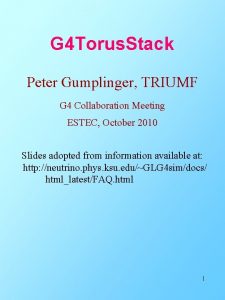


![Stack=[] digunakan untuk memebuat stack dengan Stack=[] digunakan untuk memebuat stack dengan](https://slidetodoc.com/wp-content/uploads/2020/10/1003988_042512bb86e3aab910dfb86ac5697e60-300x212.jpg)

